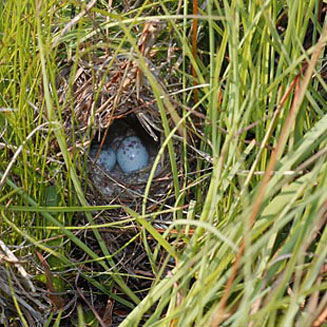|
Cisticola cinnamomeus
(Pale-crowned cisticola)
[= Cisticola brunnescens]
Bleekkopklopkloppie [Afrikaans]; Kadhi-idhi-i, Timba (generic
names for cisticola) [Shona]; bleekkop-graszanger [Dutch]; Cisticole châtain
[French]; Blaßkopfpinkpink [German]; Fuinha-de-coroa-pálida [Portuguese]
Life
> Eukaryotes >
Opisthokonta
> Metazoa (animals) >
Bilateria >
Deuterostomia > Chordata >
Craniata > Vertebrata (vertebrates) > Gnathostomata (jawed
vertebrates) > Teleostomi (teleost fish) > Osteichthyes (bony fish) > Class:
Sarcopterygii (lobe-finned
fish) > Stegocephalia (terrestrial
vertebrates) > Tetrapoda
(four-legged vertebrates) > Reptiliomorpha > Amniota >
Reptilia (reptiles) >
Romeriida > Diapsida > Archosauromorpha > Archosauria >
Dinosauria
(dinosaurs) > Saurischia > Theropoda (bipedal predatory dinosaurs) >
Coelurosauria > Maniraptora > Aves
(birds) >
Order: Passeriformes > Family: Cisticolidae
> Genus: Cisticola
Distribution and habitat
Occurs from Cameroon through southern DRC, Angola and
Zambia to southern Africa. Here it is locally common in Zimbabwe, South Africa
and southern Mozambique, preferring moist grassland, grassy drainage lines and
poorly drained areas in woodland and on airfields.
|
 |
|
Distribution of Pale-crowned cisticola in southern
Africa, based on statistical smoothing of the records from first SA Bird
Atlas Project (©
Animal Demography unit, University of
Cape Town; smoothing by Birgit Erni and Francesca Little). Colours range
from dark blue (most common) through to yellow (least common).
See here for the latest distribution
from the SABAP2. |
Food
It mainly eats insects and small
spiders, doing most of its foraging at the bases of grass tufts.
Breeding
- The nest (see image below) is a vertically-positioned oval built of live
grass bound with spider web, lined with soft plant down. It is typically
placed in a thick clump of grass very near ground level.
 |
|
|
Pale-crowned cisticola nest with eggs,
Wakkerstroom, South Africa. [photo Warwick Tarboton ©] |
|
- Egg-laying season is from November-May, peaking from December-January.
- It lays 2-5 eggs, which are probably incubated for about 11-13 days.
- The chicks stay in the nest for about 12-14 days.
Threats
Not threatened, although transformation of grassland into
farmland in South Africa is cause for concern.
References
-
Hockey PAR, Dean WRJ and Ryan PG 2005. Roberts
- Birds of southern Africa, VIIth ed. The Trustees of the John Voelcker
Bird Book Fund, Cape Town.
|
